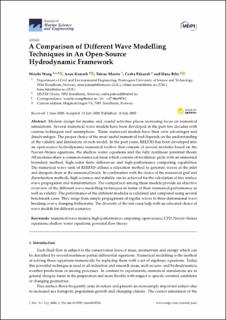| dc.contributor.author | Wang, Weizhi | |
| dc.contributor.author | Kamath, Arun | |
| dc.contributor.author | Pakozdi, Csaba | |
| dc.contributor.author | Bihs, Hans | |
| dc.date.accessioned | 2020-09-02T12:17:14Z | |
| dc.date.available | 2020-09-02T12:17:14Z | |
| dc.date.created | 2020-08-29T11:27:38Z | |
| dc.date.issued | 2020 | |
| dc.identifier.issn | 2077-1312 | |
| dc.identifier.uri | https://hdl.handle.net/11250/2676055 | |
| dc.description.abstract | Modern design for marine and coastal activities places increasing focus on numerical simulations. Several numerical wave models have been developed in the past few decades with various techniques and assumptions. Those numerical models have their own advantages and disadvantages. The proper choice of the most useful numerical tool depends on the understanding of the validity and limitations of each model. In the past years, REEF3D has been developed into an open-source hydrodynamic numerical toolbox that consists of several modules based on the Navier–Stokes equations, the shallow water equations and the fully nonlinear potential theory. All modules share a common numerical basis which consists of rectilinear grids with an immersed boundary method, high-order finite differences and high-performance computing capabilities. The numerical wave tank of REEF3D utilises a relaxation method to generate waves at the inlet and dissipate them at the numerical beach. In combination with the choice of the numerical grid and discretisation methods, high accuracy and stability can be achieved for the calculation of free surface wave propagation and transformation. The comparison among those models provide an objective overview of the different wave modelling techniques in terms of their numerical performance as well as validity. The performance of the different modules is validated and compared using several benchmark cases. They range from simple propagations of regular waves to three-dimensional wave breaking over a changing bathymetry. The diversity of the test cases help with an educated choice of wave models for different scenarios. | en_US |
| dc.language.iso | eng | en_US |
| dc.publisher | MDPI | en_US |
| dc.rights | Navngivelse 4.0 Internasjonal | * |
| dc.rights.uri | http://creativecommons.org/licenses/by/4.0/deed.no | * |
| dc.title | A comparison of different wave modelling techniques in an open-source hydrodynamic framework | en_US |
| dc.type | Peer reviewed | en_US |
| dc.type | Journal article | en_US |
| dc.description.version | publishedVersion | en_US |
| dc.source.volume | 8 | en_US |
| dc.source.journal | Journal of Marine Science and Engineering | en_US |
| dc.source.issue | 7 | en_US |
| dc.identifier.doi | 10.3390/jmse8070526 | |
| dc.identifier.cristin | 1825884 | |
| dc.description.localcode | c 2020 by the authors. Licensee MDPI, Basel, Switzerland. This article is an open access article distributed under the terms and conditions of the Creative Commons Attribution (CC BY) license (http://creativecommons.org/licenses/by/4.0/). | en_US |
| cristin.ispublished | true | |
| cristin.fulltext | original | |
| cristin.qualitycode | 1 | |

